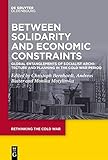Between Solidarity and Economic Constraints : Global Entanglements of Socialist Architecture and Planning in the Cold War Period / ed. by Christoph Bernhardt, Andreas Butter, Monika Motylinska.
Material type: TextSeries: Rethinking the Cold War ; 12Publisher: München ; Wien : De Gruyter Oldenbourg, [2023]Copyright date: ©2023Description: 1 online resource (VI, 291 p.)Content type:
TextSeries: Rethinking the Cold War ; 12Publisher: München ; Wien : De Gruyter Oldenbourg, [2023]Copyright date: ©2023Description: 1 online resource (VI, 291 p.)Content type: - 9783110654066
- 9783110654233
- 9783110658491
- 720.9045
- online - DeGruyter
- Issued also in print.
| Item type | Current library | Call number | URL | Status | Notes | Barcode | |
|---|---|---|---|---|---|---|---|
 eBook
eBook
|
Biblioteca "Angelicum" Pont. Univ. S.Tommaso d'Aquino Nuvola online | online - DeGruyter (Browse shelf(Opens below)) | Online access | Not for loan (Accesso limitato) | Accesso per gli utenti autorizzati / Access for authorized users | (dgr)9783110658491 |
Frontmatter -- Contents -- Global Entanglements of Socialist Architecture and Planning in the Cold War Period – Approaches and Perspectives -- I Soviet Transfer: Strategies and Limits -- Between ‘Self-Sovietisation’ and Soviet Assistance: Urban Planning and Design in China, 1950s–1960s -- Integrate, Adapt, Collaborate: Concerns of Comecon’s Technical Assistance to Mongolia during the Cold War -- Prefabricating Uzbekistan? Discourses and Realities of Urban Redevelopment in Tashkent and Samarkand under Soviet Rule -- II Networks: Comecon, GDR and the “Global South” -- A Cuban Nickel Plant made in the GDR? The Architecture of a Comecon Joint Venture -- Between Factory and Fiction – Planning and Implementation of Agro-Industrial Development Projects in Ghana in Cooperation with CMEA Countries, 1960–1966 -- Of Mobility and Earth: Hannah Schreckenbach’s Engagements with Indigenous Architectures in Ghana -- Stralsund – More than Exchange of Experiences -- III Media, Perceptions and Afterlives of Socialist Architecture and Planning -- Architecture of International Zagreb Fair between the East and West -- Shell Sheds for China: Exported Industrial Architecture from the GDR – Intentions and Reception -- Settlements of Post-Socialist Development? Reconstructing East German Solidarity through Housing Projects in the Global South after 1990 -- The Afterlife of Architectural Aid to Vietnam: A View from the Global South -- About the Authors
restricted access online access with authorization star
http://purl.org/coar/access_right/c_16ec
Until the end of the Cold War in 1990, building projects and architectural icons played an important role in the self-portrayal of the competing systems. However, as the current research shows, we also find a large variety of forms of cooperation between the East, the South, and the West, not to forget the manifold cross-border entanglements within the South or the East. This book explores the intersection of two strands of research. On the one hand, interaction in the field of architecture and construction between actors from socialist countries and from countries of the Global South have increasingly won interest amongst historians of architecture and planning. On the other hand, in the context of the strongly emerging Cold War Studies, scholars have explored cooperation and circulation across the Iron Curtain with a focus on economic and research planning. This book connects perspectives of planning, construction and architectural design with those on economic interests and conflicts in projects and networks. Furthermore, it opens the view to the hubs of communication and exchange, and on patterns of longterm transformation and appropriation of architecture.
Issued also in print.
Mode of access: Internet via World Wide Web.
In English.
Description based on online resource; title from PDF title page (publisher's Web site, viewed 06. Mrz 2024)


